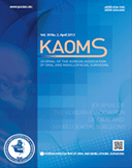Journal of the Korean Association of Oral and Maxillofacial Surgeons
- P-ISSN2234-7550
- E-ISSN2234-5930
- SCOPUS, KCI, ESCI
 ISSN : 2234-7550
ISSN : 2234-7550
Reconstruction plates used in the surgery for mandibular discontinuity defect
Abstract
Objectives: The purpose of this study was to analyze the survival rate of reconstruction plates that were used to correct mandibular discontinuity de-fects.Materials and Methods: We analyzed clinical and radiological data of 36 patients. Only discontinuous mandibular defect cases were included in the study. Reconstruction plate survival rate was analyzed according to age, gender, location of defect, defect size, and whether the patient underwent a bone graft procedure, coronoidectomy, and/or postoperative radiation therapy (RT).Results: Plate-related complications developed in 8 patients, 7 of which underwent plate removal. No significantdifferences were found in plate sur-vival rate according to age, gender, location of defect, defect size, or whether a bone graft procedure was performed. However, there were differences in the plate survival rate that depended on whether the patient underwent coronoidectomy or postoperative RT. In the early stages (9.25±5.10 months), plate fracture was the most common complication, but in the later stages (35.75±17.00 months), screw loosening was the most common complication.Conclusion: It is important to establish the time-related risk of complications such as plate fracture or screw loosening. Coronoidectomy should be considered in most cases to prevent complications. Postoperative RT can affect the survival rate and hazard rate after a reconstruction plate is fitted.
- keywords
- Mandibular reconstruciton, Complications, Survival rates
- 43Downloaded
- 151Viewed
- 0KCI Citations
- 0WOS Citations